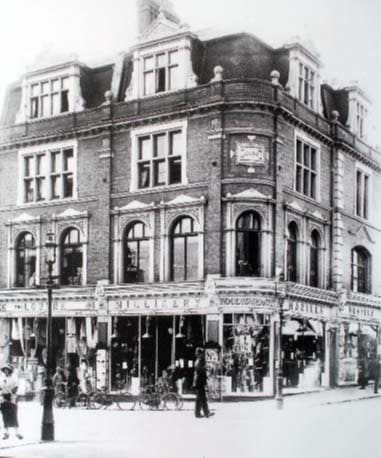
The growth of the “New Town” of Leamington into a fashionable resort gave us wide streets and fine buildings. One of these was the Royal Assembly Rooms where many “splendid balls and concerts” were held. In 1878 they were sold; and then partly demolished, partly converted into shops. Messrs. P. H. Woodward & Co. acquired the building in 1908 expanding into adjoining premises in Regent Street in 1927. Woodward’s, this rather grand and well-known department store, closed on 30th July 2004 after trading for 96 years.
As well as selling such items such as millinery, soft furnishings and linens, Woodwards was a place to go for ladies’ fashions. Later, many parents will remember having to buy school uniform for their children there.
Over the years, ladies’ fashions have changed, like most others things I suppose. Anyway, the following gives a good idea of ladies’ fashions in the 1950’s.
It’s not everyone that had a model for a mum, but Mary Lindsay is one and she is proud enough of her mum to let Nigel Briggs and myself copy photographs and information about her for the Leamington History Group website.
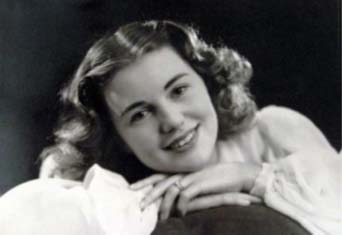
Juanita Withers nèe Hall was always known as June. She married Geoff Withers in 1942. As someone with a fair complexion, blonde hair and brown eyes, she started posing for full face photographs in 1945. She was described as very vivacious and outgoing, with some people comparing her to the actress Grace Kelly. In 1947 an opportunity came along for her to train with ‘The Lucy Clayton’ modelling agency and became a mannequin and model. In 1952, she had lessons at the Elizabeth Thompson Northern Mannequins Schools at Nottingham and Leeds and subsequently worked for the Elizabeth Thompson Mannequin Agency. She also worked in a number of other towns and cities such as Derby, Stratford Upon Avon and Birmingham. The typical fee was 3 guineas per day, plus expenses, but minus 15% agency commission.
Between 1955 and 1960, June had modelling assignments for P. H Woodward & Co. in Leamington Spa The fashion shows were called ‘Mannequin Parades’ and were held at the Town Hall. On 7th March 1957, there were the usual 3 shows at the Town Hall, at 10.45 a.m. 3.00 p.m. and 7.00 p.m. plus June had to arrange to be available for a fitting day in February. June received a cheque from Woodwards for £6. 7s. 2d. for fees and expenses in connection with the fashion parades.
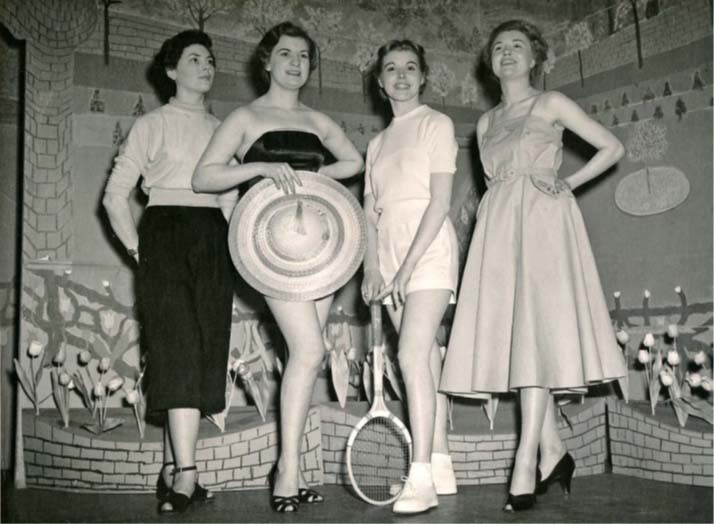
In March 1953, it was reported that ‘Sportswear will be popular this summer season, Bealuh Louks wears jeans and a sweater, Anne Edwin holds the latest idea in beach headgear, Paddy Cliff displays linen shorts, and June Withers a sun dress.’
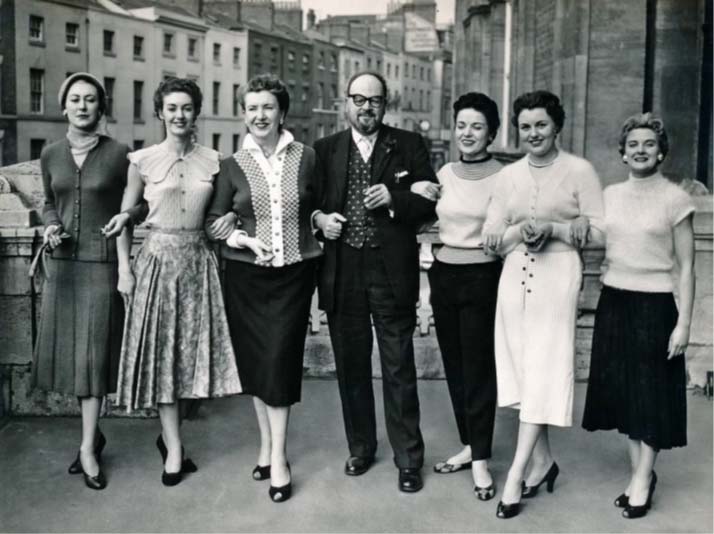
In 1956, Mr. James Norbury, the T.V. knitting expert and designer to Paton and Baldwin Ltd. was seen on the balcony of the Town Hall with six mannequins who modelled his latest designs.
A Morning News article at the time reported:
“In the past women, and even men, have been heard to criticise the names given to the new fashion shades of women’s clothes. Do you remember, ladies, that during one particular autumn season, if you were dressed in donkey brown or elephant grey you were considered to be highly fashionable? But what did these names really mean? Dark, dull brown, maybe, and plain grey?
This coming spring season, however, new shade names will really have some meaning, as was proved at Woodward’s spring fashion show, staged at the Town Hall yesterday. Citrus green, Italian pink, ice blue, coral pink, acid yellow, lizard green and siesta pink are all as exciting as they sound, and mean that the well-dressed woman this spring will look gayer than ever. If she wishes to be fashionable, she will no longer shrink from wearing bright, gaudy clothes, for they will be symbolic of the most pleasant months of the year.
An attractive Italian pink loose coat seemed at first to be impracticable, its rhinestone studded stand up collar restricting it for cocktail and evening wear only. But the collar was detachable, converting the coat for everyday wear over a suit or dress. This was priced at 15 guineas. The suits modelled indicated that the three-quarter coat will be the vogue this season.
Reminiscent of the 1920’s were dresses featuring pleated flounces, starting from the knee-line. Berkertex favoured this line in an attractive grey dress at seven guineas.
Turning from ready-made to handmade clothes, the show ended with a display of attractive and varied hand-knitted garments, introduced by Mr. James Norbury, designer for Paton and Baldwins Limited.”
The Leamington, Warwick, Kenilworth and District Morning News dated Thursday 27th September 1956 commented:
“Ladies, whether you like it or not, the “Empire” line is well and truly here. From top coats with yokes to dresses reminiscent of the early 19th century, there are traces of this fashion in almost every winter garment.
Be consoled if the line doesn’t flatter your figure by remembering that the early 1800’s were among the most spectacular and feminine in fashions and be thankful that 1956 clothes haven’t the fault of being too extreme.
Woodwards have recently opened a new ‘separates’ department and they showed a gay selection of interchangeable Continental garments. Terylene and wool is very much in evidence for smart suits and the ever-popular pleated skirts. Shower proof duffle coats are warm and gay for the young, and pencil slim double-knit jersey skirts are bright for the winter months ahead.
Skirts generally are a good collection this time, with wide selections of materials and colours for as little as £2. For readers who enjoy the luxurious appeal of corduroy, there are well cut skirts in many shades at 5 ½ guineas. For the very young and slim, spectacular trews sell at £2 15s.
Fur fabric seems to be making a “come back” and silky mohair was shown for top coats in most attractive shades of muted green and greys. Fur collars add to this season’s, “bulky look” and collars generally are large and cape like.
A Continental Jaqumar fabric dress in cheery, green and black flecked tweed teamed with a jacket in the same, but a heavier, weave, was outstanding. A smart and hardwearing buy at 15 guineas. A cactus green coat with a flattering platina fox collar was worthy of close attention, and Alexon’s interpretation of the new Paris cape on a royal blue loose-pile cloth coat had a cape edged with silver fox at 26 guineas.
Favourite Fashions have produced a practical and very reasonable priced loose coat in winter white at 11 guineas, and the emphasis on hip pockets was seen in two coats in the new shade of rose red.”
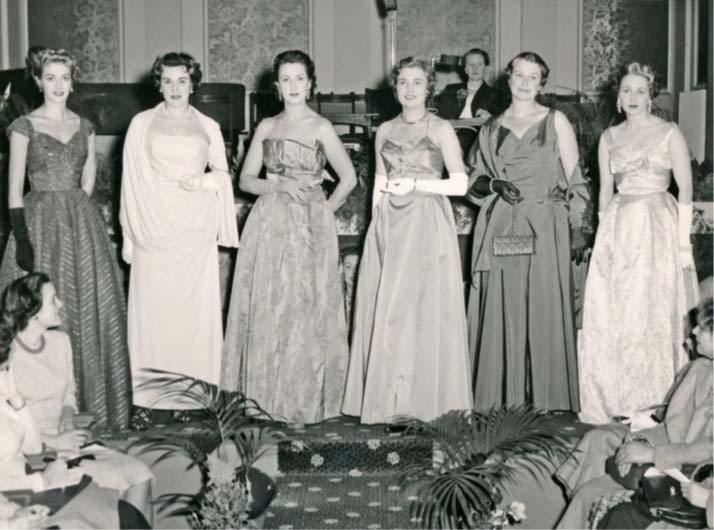
Leamington Spa Town Hall in 1956
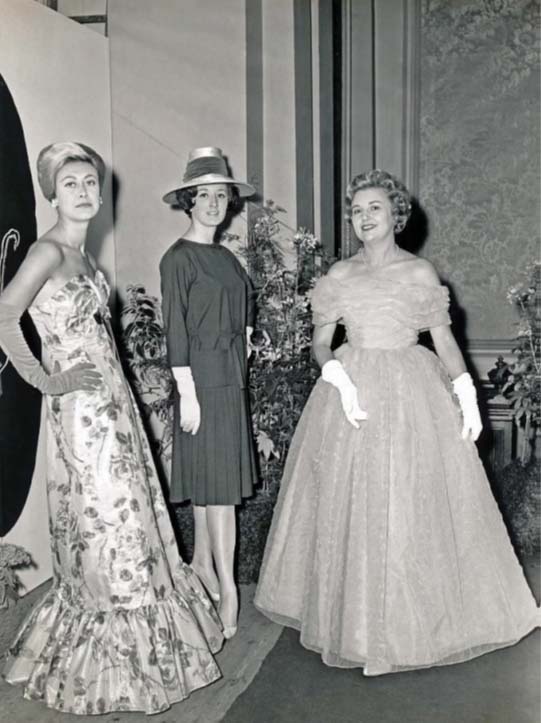
Leamington Spa Town Hall in 1956
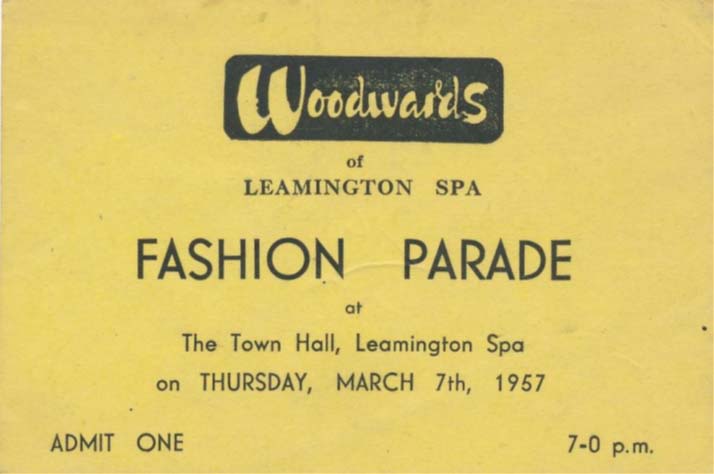
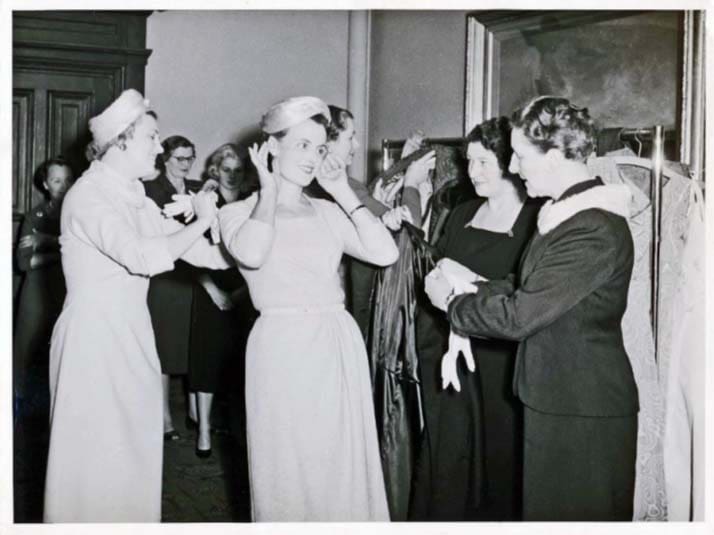
The Town Hall in September 1957
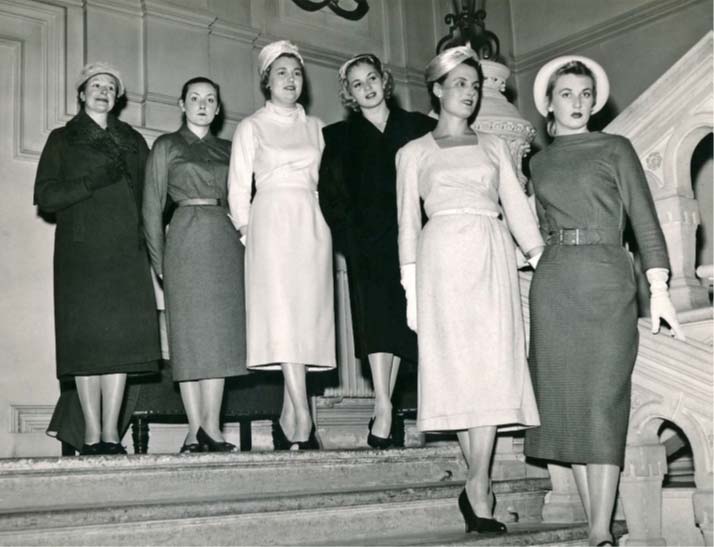
Six mannequins modelled a selection of Woodward’s autumn stock in September 1957 and posed on the Leamington Spa Town Hall steps for a ‘Courier’ photographer. They are seen wearing the less than £30 outfits which concluded the show.
The Leamington Spa Courier dated 20th September 1957 reported:
“The sack has arrived in Leamington. Yes, that much-discussed garment has made its official debut in the Spa town. And it received a very calm reception from the audiences at Woodward’s autumn fashion parades yesterday.
True, there were one or two exclamations as the blonde, slim, Kenilworth model, Jillian, mounted the dais. But nowhere could the words “ghastly,” or “I wouldn’t be seen dead in it” be heard. Which was not surprising, for it could not be denied that Jillian knew how to wear The Sack, and, whatever one may think of the long, dangling beads, they certainly complete the “20’s look”. And so do pointed-toe shoes – if you have slim enough feet to wear them.
Even the most ardent anti-Sack enthusiast could have been wooed into acceptance by the sight of Jillian. Not all of us could carry off this revolutionary style as she did. The creation chosen was of a woollen mixture with a tweedy appearance affected by mauve and yellow tiecks on a grey background. Breaking up the straight-up-and-down look was a detachable belt, loosely knotted over the hips. The cost? A mere five guineas.
Another interesting and topical feature of the show was six outfits [excluding shoes] costing less than £30. This innovation was prompted by the B.B.C.’s competition for the best dressed woman wearing an outfit costing less than £30.
Collections consisting of coat, hat, gloves and dress – varied in price from £23. 10s. to £29. 1s. 5d. and gave the fashion-conscious woman an idea of just how smart she can look on a restrictive budget.
Stoles were as much in evidence as ever, both with evening and cocktail gowns and if you choose lace for the dinners and dances which are looming on the horizon you can be sure of being in the vogue.
It seems that double jersey and fine ribbed dresses are now “musts” in a women’s wardrobe. And, incidentally, if you are fond of corduroy, look for the extra-fine varieties, which afford elegance and warmth.
As usual, a comprehensive selection of separates was shown, including an all-purpose, circular, pleated Terylene skirt, Black Watch tartan trews, a waterproof, suedette jacket, a brushed nylon twin set and a reversable car coat.
Remember the hoods on gabardine raincoats, so popular five of six years ago? They are making a comeback, but this time on coats. Headhugging, they are much more attractive, and often can be turned down to give the appearance of a collar.
This season’s most popular colours promise to be black, tomato red, peach blonde, dull moss green and rich, royal blue.
For me, the pick of the show, was an eskimo-type face flattering white pile hood – wear with anything you wish.”
In 1958, a local newspaper reported:
“Fifty years of fashion, from the early 1900’s and days of elegant long gowns in rich colours and fabrics to present day “spindle,” “cocoon,” and “trapeze,” lines, was the theme of a parade presented by Woodwards of Leamington, yesterday to mark the firm’s golden jubilee.
There were the voluminous dresses of 1908. A grey poult had a modified bustle and bows, on the skirt. A red plush bodice dipped to a V at the back over a full black skirt.
One dress was in black with lace edging on the bodice, the full skirt slightly shorter in front than at the back and edged all round with deep fringe. Another, in bottle green and grey mixture was worn over a cream pure silk blouse to reveal a neck-hugging collar and puffed sleeves.
Yes, it was all very elegant, very graceful and very demure…. and must have brought back many nostalgic recollections to more than one member of the audiences at the shows in the Town Hall.
In sharp contrast were the 1958 models incorporating many of the latest Paris trends.
The new bloused effect was to be found on a charming yellow coat, but not at haute couture prices. This one cost 16gns.
Then came the “spindle” line in a siesta pink coat, obtained by darting in the back to narrow it down towards the hemline.
A delightful colour this season is heliotrope and I particularly admired it in a Paris copy of a coat combining a standaway collar and fullness gathered under the collar at the back. This styling seemed good value at 16 gns.
Again copied from a Paris model, only a matter of a day or so ago in fact, was a “cocoon” line coat, its width being pleated into a below-the-knee band.
Yet another up-to-the-minute outfit featured the latest coffee and cream colour vogue in an attractive ensemble in double knit jersey, costing £14. 10s. Jersey knit was also used for a French blue coat in which the sleeves and back were pleated into a semi-circular yoke.
For those in search of a little more practical styling, there were numerous examples cut on straight classic lines. I noted one in royal blue, for instance, with a low slung belt at the back and brass button fastenings, reasonable priced at 12 gns., with another in the same colour at 11 gns.
Despite the present trend towards loose fitting and casual styling, there are still some women who prefer a more fitting garment, and those were not forgotten in the parade. Even the classic town suit in black was shown in a close-fitting design, while in complete contrast was a casual single-breasted tweed suit, its loose curving back eased into a wide band round the hip-lines.
The middy suit was there, too, for those who like this jaunty style, as well as the popular three-quarter length coat worn over straight narrow skirts, sometimes matching and sometimes in contrast material.
An unusual feature in the “separates” section was a navy skirt appliqued in front with a white design, but with separate apron sides which could be tied either to the back or to the front, thus covering the pattern. And just to be different, of course requires a little extra cost – eight and a half guineas.
Other items of interest were many cotton dress and jacket ensembles, a pure silk dress in Paisley design with a redingote effect created by a detachable collar and floating panels, a charming range of millinery including the “number one” Breton style, and gay “Victoriana” parasols with fluted edges in alternating colours.”
The Leamington Spa Courier dated 14th March 1958 reported:
“Just how much fashions have changed during the last 50 years was clearly indicated at Woodward’s Spring Fashion Parades, staged at the Town Hall yesterday.
The celebration this month of the firm’s Golden Jubilee provided an opportunity for a novel departure. At first, instead of seeing what the fashion-conscious woman will be wearing during the months ahead, we were shown what she wore 50 years ago.
Despite their age, the five authentic garments looked as elegant as they must have done when worn by their original owners. And, although the models seemed somewhat amused by the experience, they were at their ease in leg-o’mutton sleeves, boned bodices, nipped-in waists and bustles.
Later I compared present day umbrellas with the old parasols and realised that for the past 50 years manufacturers have merely produced variations on an original theme.
As the five graceful models left the room amidst applause, half a century was spanned in a second as another mannequin entered wearing a 16 guinea coat showing the Paris influence.
A neat swagger in a soft, yellow tweed, the slight fullness of the back is gathered into a low hipline giving a new bloused effect.
The next item emphasised that when women like a particular colour they don’t expect it to disappear quickly. And the fashion experts are obviously well in touch with our whims. Royal blue, one of the most popular shades last autumn, has not yet died out – indeed I would confidently predict that it has many more months to live. It made its first appearance in the form of a loose, single-breasted coat for the shorter woman (11 guineas), and later in a double-breasted reefer jacket with brass buttons and a low-slung half belt (12 guineas).
Whether the new shade of heliotrope will capture our hearts as easily remains to be seen. It is as distinctive as is the copy of a Parisian design in which it is incorporated. Costing 16 guineas, this coat has a stand-away collar into which the full back is softly gathered. It roomy sleeves are finished with broad cuffs.
Competition for the gentle harmonisation of coffee and cream – chosen as the season’s colours by “Vogue” – is likely to be the contrast of navy blue and white. Once considered principally suitable for older women, it is now proving its versatility. Sheath dresses with matching jackets – one has white lover’s knots on a navy background – are now being designed with the younger, sophisticated woman in mind.
Suits with boxy, three-quarter length, and semi-fitted jackets, vary in colour, spring lilac and brown-and-white dog tooth check making welcome bows. Demand for double knit jersey and Terylene and worsted in practical designs is still high, and for more dressy occasions boucle might be an apt choice.
There was the usual display of separates, headed by a gay red Dannimac raincoat with a zip replacing buttons (£6. 19s. 6d.), and a matching hat. There were also gaily coloured, delightfully bouffant cotton skirts, casual poplin blouses, blazers, sweaters, twin sets, and a smart, three-quarter length camel coat with leather buttons and buttonholes, and a special ticket pocket (16 guineas) for racegoers.
The most interesting feature of the dresses was a striking new material, knitted cotton, mainly used for dress and jacket ensembles. It has the ridged, slightly substantial appearance of knitting, but is cool and elegant. Paisley, either in pure silk or cotton, was also much in evidence.”
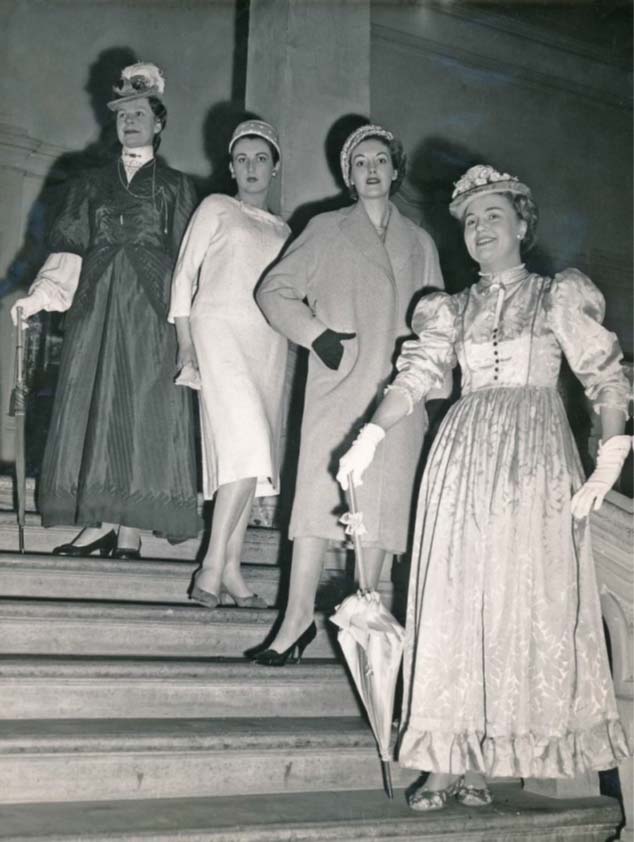
These styles contrast 1908 and 1958 at the golden jubilee fashion parade at Leamington Spa Town Hall in 1958.
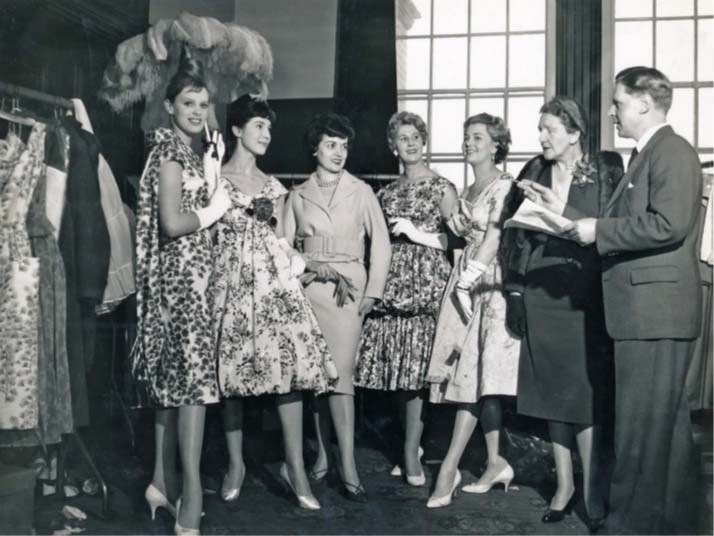
Leamington Spa Town Hall on 12th March 1959
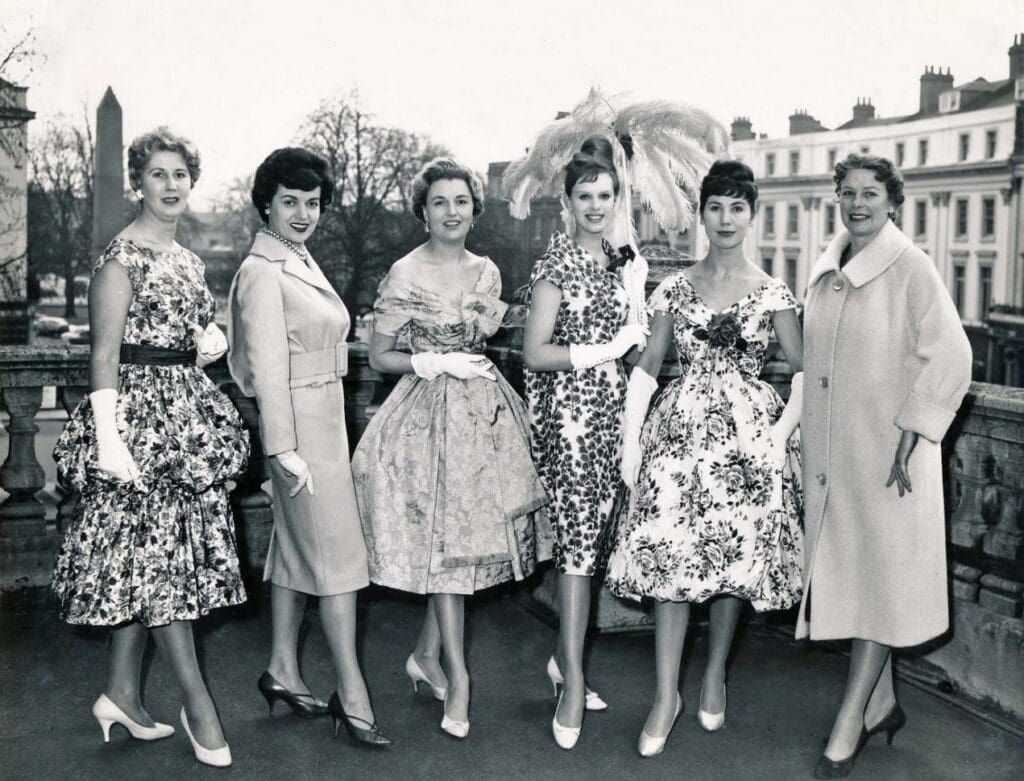
Leamington Spa Town Hall on 12th March 1959
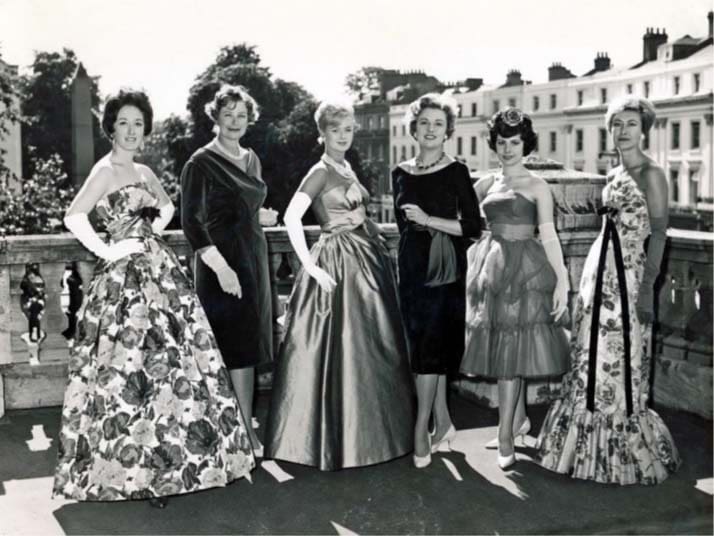
Leamington Spa Town Hall in March 1960
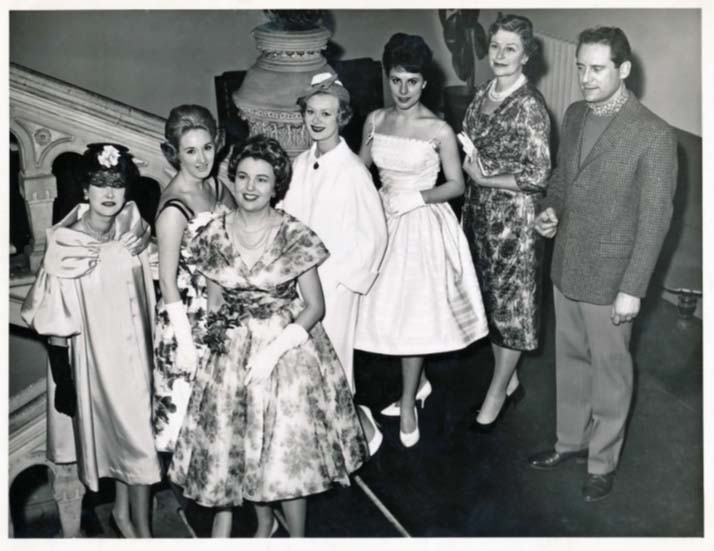
Leamington Spa Town Hall in March 1960
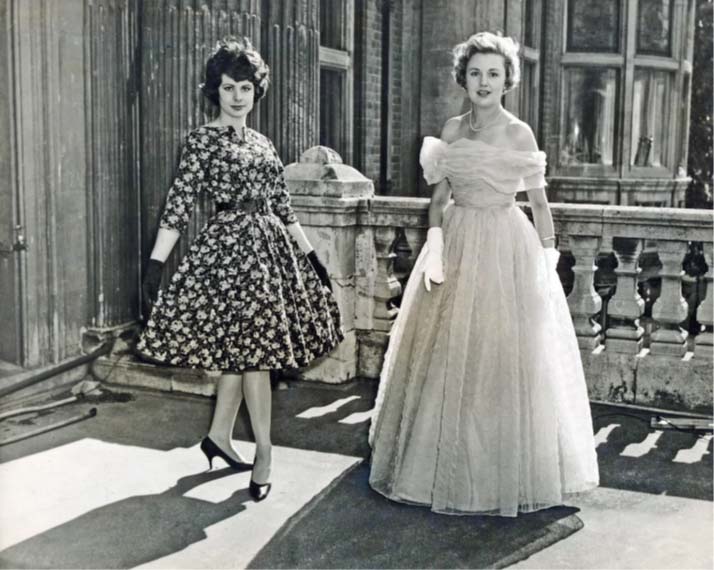
Leamington Spa Town Hall in September 1960
Allan Jennings 2025
Acknowledgements
Mary Lindsay
Nigel Briggs
Leamington Spa Courier
